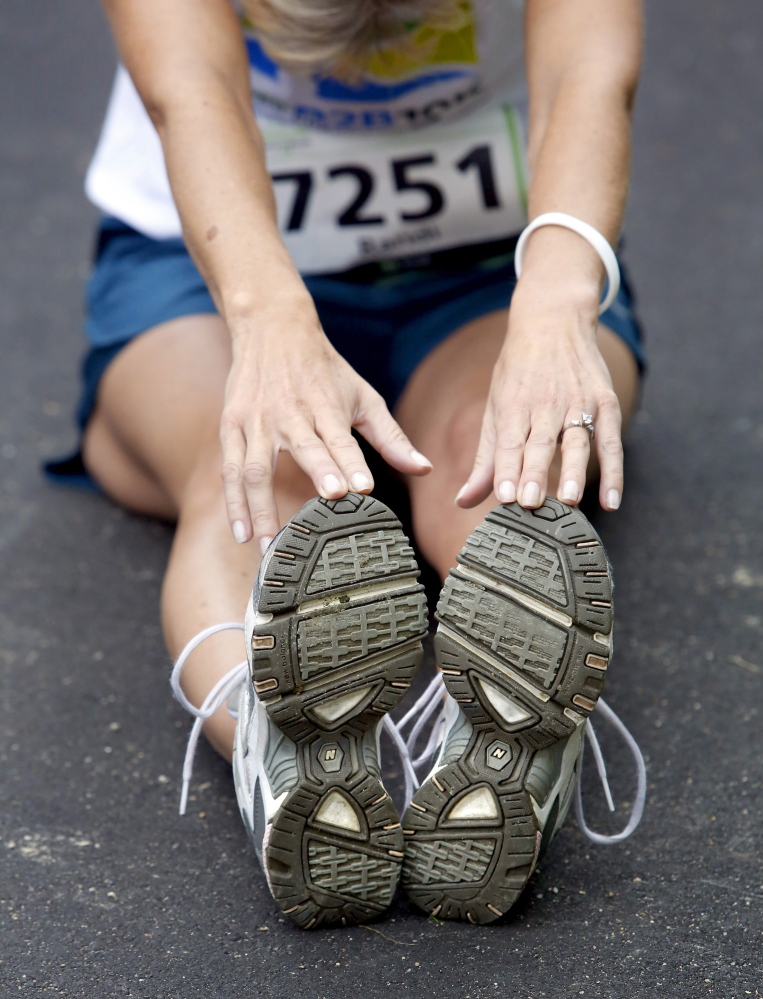Michael Bourque of Portland has been running the Beach to Beacon 10K road race for about a decade, always with the goal of breaking 50 minutes.
Last year, at age 47, he hit it right on the button, finishing in exactly 50 minutes.
“You don’t hit 50 (minutes) just by waking up and going out to run,” he said. “It takes a little work to do that.”
Three quarters of the field trailed Bourque to the finish line near the Portland Head Light – in stark contrast to the race’s first running in 1998, when more than half the entrants beat the 50-minute mark.
An analysis of 17 years of Beach to Beacon results reveals that median finishing times have risen steadily. The field is growing – reaching almost 6,500 last August after debuting with just over 2,400 runners in 1998 – but, as a group, getting slower.
Nearly four of every 10 runners took more than an hour to cover the 6.2-mile course last year. In Year One, more than eight of 10 – 83.3 percent, to be exact – beat the hour mark.
Why? Has the race become too congested?
“It did take quite a while to get started,” said Keith Grover, 58, a first-timer from Yarmouth who reached the finish in 59:57 last year. “It was pretty bunched up for quite a while.”
Route 77 is quite wide, however, and self-seeding behind the starting line according to average mile pace is encouraged so that slower runners don’t hinder faster runners.
“The start is fairly clogged,” said Harry Poole, 28, a Yarmouth native who first ran Beach to Beacon while still in high school. “But it thins out pretty quickly.”
Sarah MacColl, 59, is a personal trainer from Cape Elizabeth. She was a volunteer coordinator in the race’s early years and is a longtime runner who finished in just over 50 minutes last year after breaking 48 the previous year. She has a few theories on why the field is slowing.
More people understand that exercise slows the aging process, she said, so more runners are older.
Beach to Beacon may also be viewed differently, as more of a recreational event than a footrace.
“Ten or 15 years ago, races were for runners,” she said. “Now, races are for people who are enthusiastic.”
Indeed, Beach to Beacon has actually become two races. There’s the festive first Saturday of August with all the attendant hoopla; but first there’s the high-pressure morning in March when the registration window opens – for a matter of minutes before slamming shut.
No qualifying times are required for entry, only nimble fingers and a dependable Internet connection.
“Maybe it’s just that people with faster fingers have slower feet,” Bourque mused.
EXPLOSION OF RACERS, MANY WOMEN
In an annual state of the sport series, Running USA examines trends and demographics in the road-racing industry. The total number of finishers in races nationwide, for example, nearly tripled from 1995 to 2014 – a rise mirrored in the Beach to Beacon field. The demographics also changed, with women accounting for 59 percent of 10K race finishers last year. They were outnumbered nearly 2-to-1 in races of all distances in 1995.
“I think there’s more awareness of the healthy lifestyle,” said David Weatherbie, president of the race for its first 16 years and still on the board of directors. “So you have more people out there who are doing it from a recreational standpoint versus the hard-core road racers. You probably had a fair amount of those back in the late ’90s who ran that race in Year One.”
That’s a good thing, according to race founder Joan Benoit Samuelson, the Olympic gold medalist who trained on these same roads while growing up in Cape Elizabeth.
“What has been such a high point of the race for me,” she said, “is that it’s pulling runners off the sidelines and you’re seeing them make exercise part of their life. I think that’s why you see the (median) times increasing.”
The elite fields, she noted, show no signs of slowing. Course records have fallen four times in the past six years.
Women made up 44.5 percent of the original Beach to Beacon field but have surpassed men for the past several years, peaking at 54.3 percent a year ago. The median times for 10K races nationwide, according to Running USA, were 1:06:22 for women and 57:03 for men in 2014.
But don’t tell Renee Durgin that more women are contributing to slower times.
“To me, it seems like everyone’s getting faster,” said Durgin, 42, of Scarborough. “But maybe that’s because I’m getting older.”
Durgin finished in 39:57 last year, an achievement shared by just 3.8 percent of the field. More than 12 percent beat 40 minutes that first year, which enjoyed unusually perfect running weather with cool temperatures and overcast skies. Another beautiful day for running coincided with the 2010 race, which saw Lineth Chepkkurui set a women’s course record.
FAST OR SLOW, IT’S A ‘PINNACLE RACE’
The average age of Beach to Beacon runners has crept up a bit, from 38.2 at the start to 39.4 last year.
“It’s the pinnacle race that everyone wants to do whether they’re fast or slow or whatever, which is a good problem to have,” said Poole, the Yarmouth native now working in New York City whose entire family comes together for Beach to Beacon weekend.
Poole, a competitive Nordic skier while at Bates College in Waterville, matched Durgin’s time of 39:57 last year. This year, the move to New York disrupted his regular running routine, but he’s hoping once more to break 40 minutes.
“If I do it, great,” he said. “If not, I’ll still have fun.”
Send questions/comments to the editors.






Comments are no longer available on this story